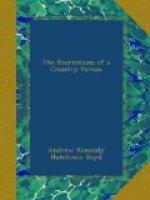After Greenock is passed, and the river has grown into the Frith, the general features of the scene’remain very much the same for upwards of twenty miles. The water varies from three to seven or eight miles in breadth; and then suddenly opens out to a breadth of twenty or thirty miles. Hills, fringed with wood along their base, and gradually passing into moorland as they ascend, form, the shores on either side. The rocky islands of the Great and Little Cumbrae occupy the middle of the Frith, about fourteen or fifteen miles below Greenock: to the right lies the larger island of Bute; and further on the still larger island of Arran. The hills on the Argyleshire side of the Frith are generally bold and precipitous: those on the Ayrshire side are of much less elevation. The character of all the places’down the water’ is almost identical: they consist of a row of houses, generally detached villas or cottages, reaching along the shore, at only a few yards’ distance from the water, with the hills arising immediately behind. The beach is not very convenient for bathing, being generally rocky; though here and there we find a Btrip of yellow sand. Trees and shrubs grow in the richest way down to the water’s edge. The trees are numerous, and luxuriant rather than large; oaks predominate; we should say few of them are a hundred years old. Ivy and honeysuckle grow in profusion; for several miles along the coast, near Largs, there is a perpendicular wall of rock from fifty to one hundred feet in height, which follows the windings of the shore at a distance of one hundred and fifty yards from the water, enclosing between itself and the sea a long ribbon of fine soil, on which shrubs, flowers, and fruit grow luxuriantly;




